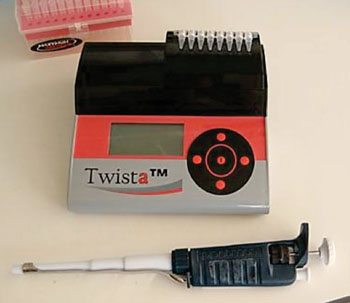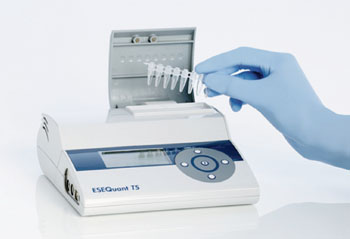Mobile DNA Test Developed for HIV
By LabMedica International staff writers
Posted on 19 Jun 2014
An efficient test to detect signs of human immunodeficiency virus (HIV) and its progress in patients in low-resource settings is being developed using recombinase polymerase amplification (RPA). Posted on 19 Jun 2014
The current gold standard to diagnose HIV in infants and to monitor viral load depends on laboratory equipment and technical expertise generally available only in clinics, while the new assay features a nucleic acid-based test that can be performed at the site of care.
Bioengineers at Rice University (Houston, TX, USA) developed a new technique that would replace a complex procedure based on polymerase chain reaction (PCR) with one that relies on RPA, a method that quickly amplifies genetic markers found in blood to levels where they can be easily counted. In the test the team calls quantitative RPA (qRPA), a specific sequence in HIV DNA is targeted and tagged with fluorescent probes that can be seen and quantified by a portable machine. Software analysis of the fluorescing DNA allows clinicians to determine with great accuracy whether the virus is present in a patient's blood and/or how much is there.
Amplification and real-time data collection were performed in a CFX96 Real Time qPCR machine (Bio-Rad; Hercules, CA, USA). Preliminary RPA experiments detecting HIV-1 DNA and internal positive control sequence (IPC) DNA in separate reactions demonstrated that the time at which detectable amplification begins, increases with decreasing DNA concentration, suggesting that quantification of DNA with RPA is feasible. The assay could potentially be optimized for greater accuracy by collecting fluorescence data more frequently or decreasing the reaction rate by either decreasing the concentration of magnesium acetate in the reaction or amplifying at a lower temperature.
This assay was designed for use with an inexpensive, point-of-care fluorescence reader, such as the commercially available Twista portable real-time fluorometer (TwistDx, Ltd.; Cambridge, UK) or the ESEQuant Tube Scanner (Qiagen; Valencia, CA, USA). To be clinically viable, a DNA-based test for HIV has to be able to quantify virus loads over four orders of magnitude, from very low to very high; the scientists reported that the qRPA test easily meets that goal. The study was published on May 26, 2014, in the journal Analytical Chemistry.
Related Links:
Rice University
Bio-Rad
TwistDx Ltd.















